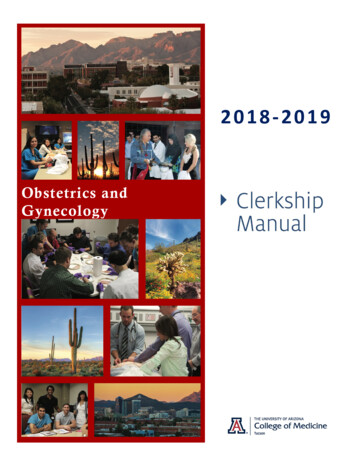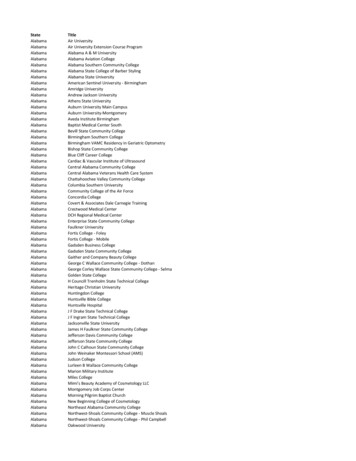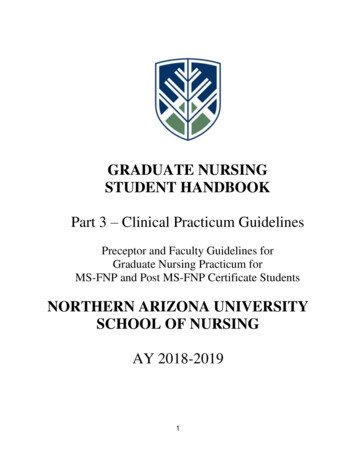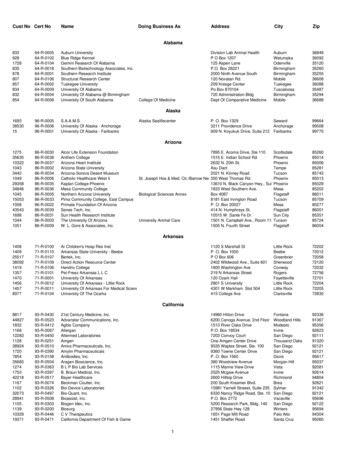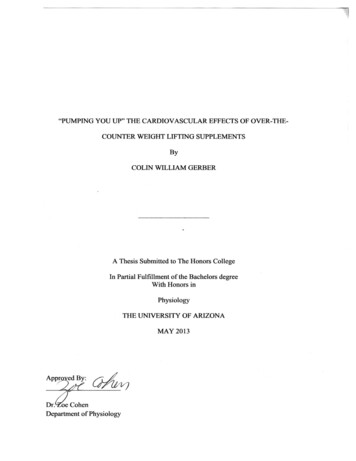
Transcription
AbstractSubsequent to the analysis of a pre-workout supplement, during-workout supplement, and postworkout supplement, it was concluded that only the post strength training recovery supplement(Optimum Nutrition’s Gold Standard 100% Whey Protein) was able to successfully fulfill allof the company’s claims as well as proved the most beneficial. It was noted that the other twotypes of supplements had some potentially negative effects on a human’s cardiovascular system,were not necessarily beneficial for strength training exercisers, and contained various ingredientswith both valid and invalid company claims. This review of the cardiovascular (CV) system incongruence with strength training supplements concludes the vital connections between the twoare important and should be heavily considered upon use of supplementation resembling any ofthe three reviewed.
Table of ContentsIntroductionIOverview of the Cardiovascular SystemIIHeart Anatomy OverviewIIBlood Anatomy OverviewIIIBlood Vessels Anatomy OverviewIVPulmonary, Systemic, and Coronary CirculationVQuantitative Measurements of Cardiovascular SystemVIIntroduction to SupplementsIXOverview of Strength Training/Weightlifting Exercise (anaerobic)IXPre-workout SupplementXIIIWhat exactly does this supplement supposedly do for us physiologically?XVIIIValidity of claims, is this supplement beneficial?XVPotential side effectsXVIMuscle Development Supplement (Creatine-containing)XVIWhat exactly does this supplement supposedly do for us physiologically?XVIIValidity of claims, is this supplement beneficial?XVIIIPotential side effectsXVIIRecovery SupplementXXIIIWhat exactly does this supplement supposedly do for us physiologically?XXIVValidity of claims, is this supplement beneficial?XXIVPotential side effectsXXVIEndurance Exercise (aerobic)XXVIITarget XXXV
IntroductionIt has become essentially common knowledge in the modern era that regular exercisereflects a healthy way of living. Many women and men have chosen the route of exercise thatincorporates resistance and free-weights labeled as strength training. Strength-trainingindividuals’ goals are to increase muscle size, anaerobic endurance, and muscle strength. Priorstudies have found that strength training without supplementation benefits the cardiovascular(CV) system, by several factors including the lowering of an individual’s blood pressure as wellas increasing Basal Metabolic Rate (BMR). 12In today’s society it has become a trend to utilize various fitness and exercisesupplements to enhance and promote a healthy lifestyle. However, many people do not realizethat these supplements have specific effects on the cardiovascular system, and that there arepotentially negative effects if used improperly. The supplements to be analyzed in this thesis areones that are very often used and target strength training/weightlifting exercisers. Dietarysupplements for strength training individuals can be categorized into three main categories: PreWorkout, Muscle Development (During Workout), and Post-Workout supplements. Here weanalyze one specific supplement of each category and analyze the supplement’s claims, potentialbenefits, and potential side effects pertaining to the cardiovascular system.I
Overview of the Cardiovascular SystemThe cardiovascular system is composed of the heart, blood, arteries, capillaries, andveins. The anatomy of these constituents is important because it enables us to understand thefunction of each of these main parts of the system.Heart Anatomy OverviewThe heart is approximately the size of a human’s fist and is located within the pericardialcavity of the thorax, anterior to the human vertebral column and posterior to the sternum. Theheart is composed of three different layers as follows (from outer to inner): epicardium,myocardium, and endocardium. The epicardium is composed mostly of connective tissue servingas a protective layer for the heart. The myocardium consists of cardiac muscle which allows forthe heart to contract and relax, and the endocardium consists of endothelial-like (single layeredand flattened) cells that are in contact with the blood pumped by the heart. The whole heart isdivided into four chambers that work together to pump blood to the lungs as well as to varioustissues, such as muscle, throughout the body. There are two atria that are superior to and supplyblood to the two ventricles that are responsible for ejecting blood. The paired right atrium andventricle are separated by the tricuspid valve while the paired left atrium and ventricle areseparated by the mitral (bicuspid) valve. The right ventricle connects to the pulmonary artery viaa semilunar valve where blood flows out to the pulmonary circulation system. The right atriumreceives deoxygenated blood through the inferior and superior vena cava from the tissues. Theleft atrium is connected to the pulmonary veins that return blood from the lungs. The leftventricle connects to the aorta via a semilunar valve and ejects blood into the systemiccirculation.II
Figure 1.0Chambers of the Heart6Blood Anatomy OverviewThe substance within the cardiovascular system that allows for oxygen and nutrienttransportation throughout the body is the blood. The blood consists of red blood cells, whiteblood cells, platelets, and plasma. The main cells of interest in the cardiovascular system are thered blood cells since they are the cells that are responsible for oxygen transport. Mature redblood cells lack a nucleus making them flexible which is important so that they may squishthrough small openings and allow for gas diffusion at the lung capillaries where they areoxygenated. The major molecule within red blood cells, called hemoglobin, contains hemegroups which have four iron atoms that are able to temporarily bind to oxygen with a highenough affinity to retain oxygen and a low enough affinity to release oxygen to muscles andtissues in the systemic circulation. Once oxygen is released via diffusion to the tissues that aremetabolically active, hemoglobin is then able to bind the waste product, carbon dioxide, anddeliver it back to the pulmonary capillaries where it diffuses into the lungs and is exhaled.III
Figure 1.1CO2 transfer from tissue to red blood cell7Blood Vessels Anatomy OverviewThe blood vessels of the cardiovascular system consist primarily of the arteries, veins,and capillaries. The arteries carry blood away from the heart and contain three layers as followsfrom superficial to deep: tunica externa, tunica media, and tunica intima. The tunica media is thethickest layer consisting of mostly vascular smooth muscle cells. The main arteries in thecardiovascular system are the aorta, carotid artery, subclavian artery, celiac trunk, mesentericarteries, renal artery, and the iliac artery. The veins of the cardiovascular system are responsiblefor returning blood to the heart and have the same layers described in the arteries except thatveins lack the tunica intima. Generally the veins are much thinner than arteries and they havemuch less smooth muscle since they are not meant to contract. It’s important to note that theveins contain valves that prevent backflow of blood, helping maintain a unidirectional bloodflow. Major veins within the cardiovascular system are the subclavian vein, jugular vein, renalvein, and iliac vein. The capillaries of the cardiovascular system are the smallest blood vesselsand are essentially the endothelial lining with the thickness of one cell. Their main function is toallow for gas diffusion in the lungs, tissues, and systemic muscles.IV
In order to understand the function and importance of the cardiovascular system, it isimportant to address the three circulation systems within it: Pulmonary Circulation, SystemicCirculation, and Coronary Circulation.Pulmonary, Systemic, and Coronary CirculationThe Pulmonary Circulation is the segment of the cardiovascular system that distributesoxygen-depleted blood from the heart via the pulmonary artery to the lungs. Deoxygenated bloodenters the heart’s right atrium via the inferior and superior venae cavae and travels through thetriscupid valve into the right ventricle. Upon right ventricular contraction, the deoxygenatedblood flows through the pulmonary semilunar valve into the pulmonary artery. The oxygendepleted blood moves from the pulmonary capillaries in the lungs where it is oxygenated, andthen returns to the heart via the pulmonary vein.The Systemic Circulation involves the flow of blood from the heart to all parts of thebody with emphasis on highly metabolic organs. This particular system drives oxygenated bloodaway from the heart to parts of the body in need of oxygen in order to function, such as skeletalmuscle and tissues. Once blood is pumped to these various regions and oxygen is utilized, theoxygen depleted blood returns to the heart to be pumped back into the pulmonary circulation.The Coronary Circulation is responsible for providing blood flow to the heart itself,separate from the Pulmonary Circulation. Oxygenated blood flows to the myocardium (heartmuscle) via the coronary arteries and deoxygenated blood is carried away from the myocardiumvia the cardiac veins.V
Figure 1.2Pulmonary and Systemic Circulation5Quantitative Measurements of Cardiovascular SystemUnderstanding the various physics involved with the cardiovascular system is alsoimportant in understanding the function of the system and allows for mathematical analysis ofblood flow. Calculated values of blood flow that are notable include cardiac output (CO), endsystolic and diastolic volume (ESV and EDV), stroke volume (SV), heart rate (HR), and bloodpressure (BP).Cardiac output (CO) is described as the rate at which the heart is pumping outblood per minute (measured in Liters/minute). The end-diastolic volume (EDV) is defined as thevolume of blood that is pooled into the left ventricle from the left atrium before contractionoccurs and has an average value of 135mL1. The end-systolic volume (ESV) is the amount ofblood that remains in the left ventricle after contraction and seen as an average of 65mL1.Thestroke volume (SV) is defined as the volume of blood (in ml) that is pumped out of the leftventricle per heart beat. Heart rate (HR) is simply the amount of times the heart beats per minute.VI
The average untrained human has a general heart rate of 72 beats/min and a stroke volume ofapproximately 70mL2. The blood pressure (BP) is the amount of pressure exerted by circulatingblood onto the walls of the blood vessels. Blood pressure is recorded the systolic blood pressurewritten over the diastolic blood pressure in millimeters of mercury (mm Hg). The average adultblood pressure is approximately 120mm Hg/ 80mm Hg1.In order to correlate all the previously described aspects of the cardiovascular circulationsystem, various equations are used to find the values of each and relationship to each other. Thestroke volume is the difference between the end-diastolic volume and end-systolic volume(EDV-ESV SV). Cardiac output is equivalent to the stroke volume multiplied by the heart rate(CO SV x HR ) and is known to have an average value of approximately 5 L/min2. It isimportant to note that the average adult has approximately 5L of blood; therefore approximatelythe total quantity of blood is circulated throughout the body every minute.The electrical conduction aspect of the heart explains the way in which electric signalsare propagated to allow the heart to continually beat. The heart is considered auto-rhythmicbecause the sino-atrial (SA) node is able to propagate electric signals on its own without outsidestimulation. The heart’s electrical conduction system starts with SA node and electric impulse ispropagated down to the atrioventricular (AV) node located in the inter-atrial septum close to thetricuspid valve. There is a miniscule delay in time between electric potential movements fromthe SA node to the AV node to allow for the ventricles to fill with blood. Potential then movesfrom the Bundle of His and then to the Purkinje fibers in the ventricular walls of the heart. Theelectrical impulse then stimulates contraction of the muscle of the ventricles’ walls causing thepumping of blood out of the heart.VII
Electrocardiograms (ECG or EKG) are utilized to view the pathway of electric potentialthroughout the heart. An EKG is viewed as a graph that represents the different parts ofstimulation within the heart, with different peaks and troughs marking the key points of electricalconduction. A typical EKG notes the following important parts in a chronological manner: Pwave, Q-R-S complex, and the T-wave. The P-wave represents atrium depolarization and the QR-S complex reflects the depolarization of both the left and right ventricles. More specifically,the Q-R-S complex is broken into the Q-wave representing the depolarization of theinterventricular septum, the R-wave marks the depolarization of the ventricles, and the S-waverepresenting downward deflection following the R-wave.3 The T-wave shows the repolarizationof the heart’s ventricles3. Correlation of an EKG to parts of the heart is shown below.Figure 1.3, Figure 1.4To the left, the cardiac conduction system and how it corresponds to an EKG graph on right4VIII
Introduction to SupplementsAs seen above, the cardiovascular system is a system that needs to be regulated in greatdetail in order to keep our bodies in homeostasis throughout the duration of our lifetime. Intoday’s society it has become a trend to utilize various fitness and exercise supplements toenhance and promote a healthy lifestyle. Many of these supplements are used nation-wide andeven world-wide as people strive to obtain a more healthy and fit image. What many people maynot realize is that these supplements might have potential dangers and side effects, specificallywithin the cardiovascular system, if used improperly. Pre-workout energy, muscle development,and muscle recovery supplementation are three categories that are most commonly utilized. Thefollowing provides an example of a popular supplement for each of the mentioned categorieswith a brief explanation on what exactly they are meant to do physiologically. Before getting intothe detailed analysis of these supplements, it is vital to understand what type of exercise they aremeant to enhance as well as understand the defining factor of the exercise, strength training.Overview of Strength Training/Weightlifting Exercise (anaerobic)The particular type of exercise that the analyzed supplements are mostly utilized for areanaerobic exercises, particularly weightlifting. This is commonly referred to a type of resistancetraining labeled “strength training” in which an individual’s goals are to increase muscle size,anaerobic endurance, and muscle strength.8 Strength training can be further categorized into twomain types depending on the movement involved in the exercise. The first is isotonic exercisewhich means that the muscle is working against an opposing force such as inertia, momentum, orgravity.10 Isotonic exercises involve the two main types of training that present day supplementsare made to aid; resistance and weight training10. The second general form of strength training isisometric exercise in which the working muscle group provides an equivalent amount of force toIX
that opposing it so there is no net movement. 10 For the purposes of analyzing the effects ofsupplements’ physiological effects on the cardiovascular system, isotonic exercise strengthtraining will be the analyzed type of training. More specifically, the “weight training” categoryof isotonic exercise will be the main focus in terms of its benefits to the cardiovascular systemWeight training is typically done by utilizing the force of gravity and additional weightto provide a force that opposes muscle contraction. In doing this, skeletal muscle is able toincrease in strength and size causing hypertrophy of myofibrils in skeletal muscle.9 It isrelatively important to understand the anatomy of a muscle cell unit when analyzing how weighttraining can benefit our cardiovascular system. A sarcomere is the basic functional unit of amuscle and is composed of thin filaments called actin, thick filaments called myosin, as well asvarious proteins and enzymes necessary for contraction.11 For conventional purposes, thesarcomere has various regions of space that constitute the movement of a sarcomere duringcontraction. The figure below helps to explain the movement involved during contraction.X
Figure 1.5: Anatomy of the Cardiac Sarcomere11“ (A) Diagram of the basic organization of the sarcomere. The sarcomere forms the basiccontractile unit in the cardiomyocytes of the heart. Thin filaments composed of actin areanchored at the Z line and form transient sliding interactions with thick filaments composed ofmyosin molecules. The M Line, I Band, and A Band are anatomical features defined by theircomponents (actin, myosin, and cytoskeletal proteins) and appearance in polarized light. Titinconnects the Z line with the M line and contributes to the elastic properties and force productionof the sarcomere through its extensible region in the I Band. Coordinated shortening of thesarcomere creates contraction of the cardiomyocyte. (B) Representation of the major proteins ofthe cardiac sarcomere. Attachment to the ECM is mediated by costameres composed of thedystroglycan–glycoprotein complex and the integrin complex. Force transduction andintracellular signaling are coordinated through the costamere. The unique roles of each of theseproteins are critical to appropriate function of the heart. T-cap, titin cap; MyBP-C, myosinbinding protein C; NOS, nitric oxide synthase.” 11XI
The benefits weight training has on the human cardiovascular system specifically areseen in the blood component as well as heart tissue. It is important to know the Basal MetabolicRate (BMR) in humans which is defined as the amount of energy expended per day by humans atrest. Since the act of weight lifting as a re-occurring habit increases general muscle mass, thisallows for a correlated increase in BMR, which in turn promotes decreased lipid concentration inthe blood.12 The blood in weight lifting individuals can be seen to impart a lower blood pressure,increased high-density lipid cholesterol (HDL), decreased low-density lipid cholesterol (LDL),decreased triglycerides, and increased GLUT-4 density.12 This reduces the risk of cardiovasculardisease by allowing for less lipid accumulation in blood vessels which reduces the probability ofabnormal blood flow due to clotting. 12 These beneficial factors lead to a noticeable increase incardiovascular factors such as the efficiency of cardiac output (see background pg. 5).In relation to the benefits in heart tissue, weight training provides evident increases inmuscle size, endurance, and strength as earlier mentioned. This relatively small yet healthyamount of hypertrophy in heart tissue in strength training allows for an increased rate ofemptying in the heart’s left ventricle (although seen more significantly in aerobic cardioexercises).13 This leads to a beneficial decrease in the end-systolic volume in the left ventricle(see background pg. 5). Increasing the amount of blood emptying out of the left ventricle thenallows for an increase in cardiac output (CO) and hence an increase the tension required by theventricle to overcome the aortic pressure.13 This tension or stress is named “afterload” and ismore generally referred to the pressure the ventricle must overcome to eject blood. Thisbeneficial increase in afterload reduces the risk of cardiovascular disease by essentially reducingthe energy the heart needs to expend to promote healthy blood flow.13XII
Pre-workout Supplement1. Cellucor’s C4 Extremea. Claims: Cellucor’s C4 Extreme is a pre-workout supplement that claims topossess “the power to ignite your mind, muscles, and workout regimen.” Thecompany Cellucor recommends that C4 Extreme is mixed with water but alsomentions that juice can be used as a substitute.This pre-workout supplement hasnotable active ingredients such as creatine nitrate, beta alanine, arginine AKG,caffeine anhydrous, Vitamin B12, and N-Acetyl-L-Tyrosine. 14Figure 2.0, Figure 2.1b.Product in selling container to the left and its nutrition facts to the right14c. What exactly does this supplement supposedly do for us physiologically? Thisparticular supplement is utilized by exercisers who want a boost of energy beforethey begin their exercise. It is most commonly used by strength training weightlifters as it provides energy to skeletal muscle for a more so immediate boost inenergy for quick movements as opposed to sustained energy for enduranceXIII
exercise. Caffeine anhydrous is simply a form of caffeine that is in powder formand as most people know, is utilized to boost energy and alertness, hence why it isused in this pre-workout supplement. On a relatively intrinsic basis, caffeineworks by the mobilization of excess calcium ions from the sarcoplasmic reticulumto remove Troponin C in striated cardiac muscle and induce contraction.However, a more likely mechanism for this supplement is acting as an antagonistto adenosine which leads to the increase in neurotransmission of neurotransmitterssuch as acetylcholine, epinephrine, dopamine, serotonin, norepinephrin, andglutamate. All of these neurotransmitters stimulate the central nervous system andtherefore provide more energy to skeletal muscles throughout the body. From aphysiological standpoint, this increase in the previously mentionedneurotransmitters is known as a positive inotropy, meaning they cause an increasein cytoplasmic calcium in myocardial contractility. This increase in contractilityallows for the heart rate to increase as well as stroke volume to increase andtherefore leading to an increase in cardiac output.15 (see background)d. One of the main ingredients that the company Cellucor promotes in their productis creatine nitrate, which has had very little published research conducted on it.The only viable information found about this product was that a study wasconducted at UCLA and found creatine nitrate to be 1000% more solublecompared to creatine monohydrate. Nonetheless, the main incentive behindadding creatine nitrate is to increase calcium levels that creatine provides skeletalmuscle and the amino acids (L-arginine and Arginine AKG) to increase the levelsof nitric oxide production. This increase leads to vasodilation of blood vessels andXIV
therefore permits greater blood flow to the skeletal muscle advantageously duringweight-lifting exercises.16e. Validity of claims, is this supplement beneficial? Yes and No. For the mostpart, the claims made by Cellucor about their pre-workout supplement are correctin terms of stimulation of the central nervous system in order to provide the userwith a heightened sense of energy and alertness. This accounts for stimulation dueto the ingestion of the following ingredients found in Cellucor: caffeineanhydrous, nitric oxide, and vitamin B12. Although the claims made by thecreatine nitrate seem to be correct in terms of its physiological effects as anenergy stimulant, there is too little research conducted on this fused compound toverify it. The NO3 compound that is fused with creatine is commercially known asa vasodilator, causing vasodilation and thus an increased blood and oxygen supplyto exercising muscles. 17 However, the supposed mechanism of the amino acids LArginine and Arginine AKG leading to an increased nitric oxide amount havebeen proven to be false. 17 A potential reason for this falsification is that the pH ofstomach acid is lower (pH 2.0) than the pKa of Arginine (pKa 2.5) and thereforewould result in neutralization via protonation of Arginine. 17 Thissupplementation does not increase plasma concentrations of nitric oxidederivatives. However as an overall stimulant pertaining to the energy provided tothe exercising muscle in use, Cellucor’s C4 Extreme product seems to be anadequate supplement.17i. Caffeine anhydrous and nitric oxide derivatives are the main stimulantingredients in this pre-workout supplement, but two other ingredients playXV
a role that should be considered: Vitamin B-12 and Niacinamide. Whileboth of these B vitamins improve blood circulation and energysupplementation to the brain and central nervous system, it may also causesome potential problems and side effects. Although toxicity has not beenposed as a problem for doses of these vitamins in supplements, it shouldbe noted that location-specific injection may not be beneficial.18f. Potential side effects: Some major side effects that may occur with this kind ofsupplementation such as kidney and liver damage and water-retention problems.As most central nervous system stimulants do, Cellucor’s C4 pre-workoutsupplement can cause various side effects such as nervousness, irritability,insomnia, addiction and dependency, heart palpitations and rhythm abnormalities,weight loss, tremors, mild hypertension, hallucinations, convulsions and heartattack. From a cardiovascular standpoint, heart palpitations and dysrhythmia cancause serious concern as they negatively affect normal blood flow, bloodpressure, breathing rates, etc.19Muscle Development Supplement (Creatine-containing)2. BSN Cell Mass (concentrated post workout recovery)a. Claims: This supplement claims to emphasize muscle development and recoveryfollowing resistance training. BSN recommends mixing this supplement withwater, but also mentions its ability to be soluble in “any beverage of your choice.”It contains the following active ingredients: whey protein hydrolysate, LGlutamine, Taurine and Banaba extract, Creatine HCl (Con-Cret ), CreatineXVI
Monohydrate, and Creatine Anhydrous. BSN claims that Cell Mass advantagesinclude “promoting more efficient recovery, combating muscular fatigue andbreakdown, and supports muscle strength, endurance and overall performance.” Inaddition this supplement contains cinnulin (cinnamon extract) which is claimed tohelp regulate blood sugar levels.20Figure 2.2b.Product in selling container to the left and its nutrition facts to the right 20c. What exactly does this supplement supposedly do for us physiologically?Since protein and amino acids’ claims were previously described and proven to bebeneficial, the main emphasis for this product will be on the its main ingredientcreatine. Creatine comes in three different forms in this supplement, creatinemonohydrate, creatine HCL (Con-Cret ), and creatine anhydrous. Creatinemonohydrate has been described as the type of creatine that gives weight liftersand athletes increased muscle mass while still retaining muscle tone and leanness.In general, creatine has been seen in various studies to improve performance instrength training weight-lifters in by increasing testosterone, muscle insulin-likeXVII
growth factor-I (IGF-I), as well as increasing energy available to the exercisedmuscles.21 The most significant of these increases is the energy available to themuscles being worked.21When used as a supplement, creatine helps toresynthesize ATP from ADP via phosphocreatine (PCr) by utilizing the reversiblereaction enhanced by creatine kinase (CK). This allows for an increase in energysupply to the cells that are in high demand of it, specifically skeletal muscle cellsfor our purposes.a.Validity of claims, is this supplement beneficial? Yes and No. Thissupplement’s use of creatine in the three various forms described above do indeedincrease muscle mass and recovery via the ATP restoration mechanism earlierdescribed. Adenine Triphosphate (ATP) is the energy source utilized by thehuman body in order for energy-dependent reactions to occur such as musclecontraction. The three phosphate groups attached to the adenine group are thegroups that are used as energy sources for cells, muscle cells in this case, whenthey are broken off one by one by the enzyme ATPase (see Figure 2.1). Thisverifies the supplements ability to “promote more efficient recovery, combatmuscular fatigue and breakdown, and support muscle strength. In addition, thecreatine kinase cycle described above couples with the myosin ATPase cycle inorder to regenerate ATP in muscle tissue via phosphocreatine dephosphorylation(see figure 2.2).22XVIII
i.Figure 2.323ii. Figure 2.4 24XIX
iii. The reason that this supplement does not meet all of its claims from aphysiological and cardiovascular standpoint is because there is notsignificant evidence that it increases exercise endurance. The energyexpenditure involved in resistance training while using this product leadsto potentially more acute affects involving the ability to resist (lift more)weight, but not exactly effecting the amount of time exercising.22 Inaddition the potential harmful side effects explained below may play acounter role in its advantages.iv. Additional active ingredients: An ingredient with unknown functionwith regards to this supplement is cinnamon extract (anhydrous cinnulin)which has been observed by various clinical studies to reduce sugar (bloodglucose) levels. 25 Not only was this ingredient found to help in glucoselevel regulation, it was also noted to play a role in reducing blood pressureand reduce body fat. The concluded mechanism is that the cinnulinreduces fasting blood glucose (FBG) levels by utilizing its bioactivestructure (doubly-linked polyphenol type-A polymers) in circulating bloodin an unknown detailed mechanism. 25 This bioactive cinnulin enhancesinsulin activity which in turn lowers the FBG and ultimately lowerssystolic blood pressure (SBP) by lowering the viscosity of circulatingblood.251. Currently, cinnamon extract is a highly discussed subject in termsof the health benefits it potentially brings. A study done in 2010 byB
Subsequent to the analysis of a pre-workout supplement, during-workout supplement, and post-workout supplement, it was concluded that only the post strength training recovery supplement (Optimum Nutrition’s Gold Standard 100% Whey Protein) was able to successfully fulfill all of th
